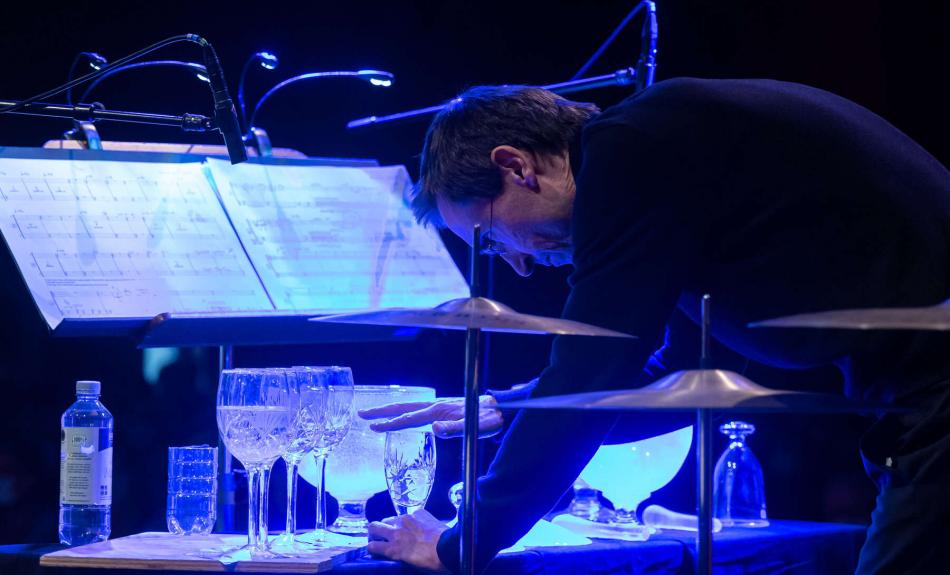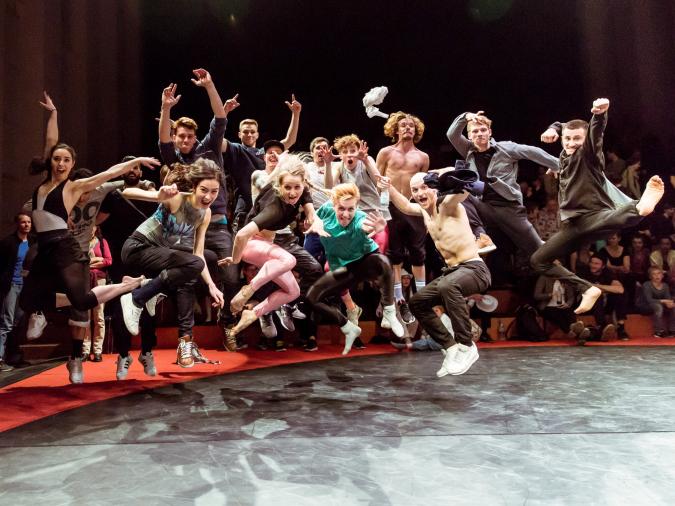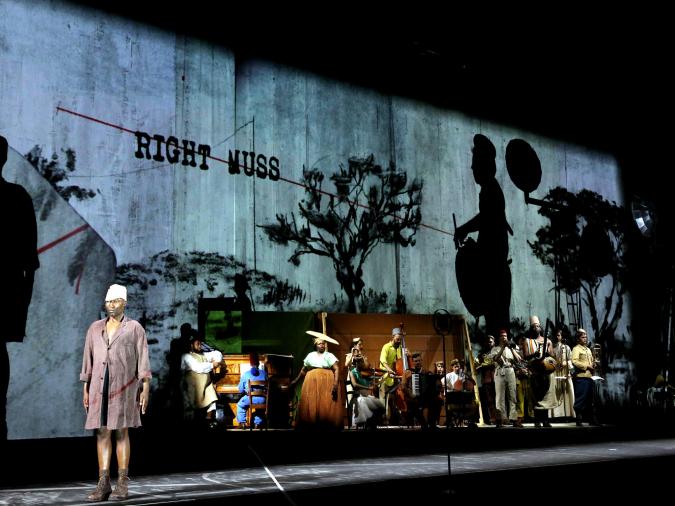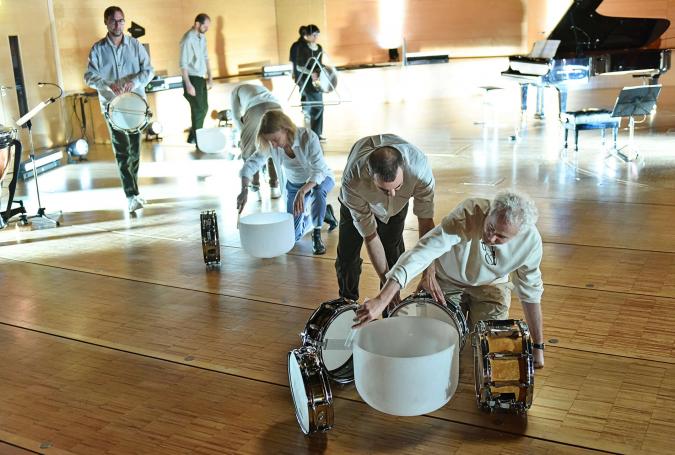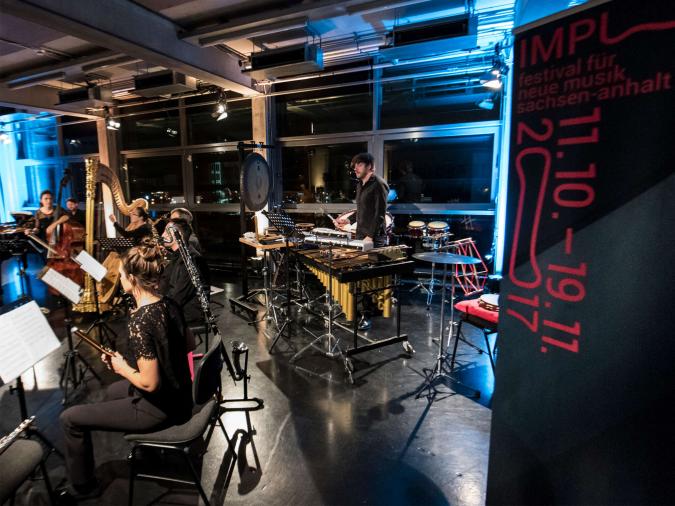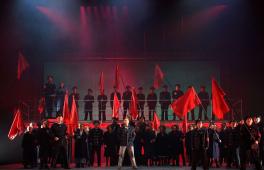The infrastructure of contemporary music in Germany is remarkable for its diversity. The very number of German synonyms for the ‘serious’ music of the last 100 years, as well as its performance and publication, suffices to convey an initial impression: contemporary music, music of the 20th and 21st centuries, modernist music, musical modernism, music of our time, present-day music, avant-garde music, new music, New Music, newest music: all these and many more have their current German equivalents. The wide range of terms, most of them coined by journalists or concert organisers, has been augmented over the years by more inclusive concepts such as sound art (Klangkunst), audio-visual art, performance art, audio art, radiophonic music, ars acustica and music on the Web. The associated phenomena often lie in an intermediate realm between the visual arts and art music. They can take the form of resonant spaces or resonating objects; they can also toy aesthetically with the manifold technical possibilities of new media and cross traditional boundaries between art forms. These modes of expression are likewise often classified as contemporary music and presented as such at the standard festivals and in trade journals. The same applies to improvised music, which vacillates between established jazz and the ‘serious’ avant-garde, and to so-called new music theatre, which has parted company with narrative opera and drawn a large following since the 1990s. In short, contemporary music is neither a stable and sharply defined concept, nor does it point to a precisely demarcated aesthetic terrain. Rather, it designates a remarkably broad and varied range of acoustical creations, both of today and of recent decades, as well as a multilayered, open-ended and increasingly inclusive scene that has thrived chiefly on the spirit of ‘serious’ music – until now, at any rate. For the boundaries separating contemporary art music from established forms of popular music and jazz, which are evolving at an even more dizzying pace, and conversely those separating popular music from contemporary art music, are becoming increasingly blurred. The former lines of demarcation are rapidly vanishing, so that the spectrum of what can be termed ‘contemporary music’ will expand to embrace a large and diverse terrain of musical creation.
The steadily growing multiplicity in contemporary music is a striking feature of our times, and one that should be seen in a positive light. Never in the past 100 years has so much contemporary music reached the public as it does today, and never have there been so many specialist ensembles. These developments, however, which have been particularly dynamic since the 1980s, go hand in hand with a sharply growing need for funds to finance concerts and projects. For contemporary music, like every other form of ‘serious’ music through the ages, stands in need of material support from society. Yet the cutbacks in cultural funding (or stagnating budgets with growing inflation), some of which have lasted for years, can limit the further evolution of contemporary music as a live experience. At least a number of municipalities and federal states have raised their previous subsidisation in this area in response to the ‘New Music Network’ project (Netzwerk Neue Musik) initiated by the Federal Cultural Foundation from 2007 to 2011. Similarly, in 2016 the federal government established another subsidisation tool for contemporary Klangkunst at the initiative of the Federal Government Commissioner for Culture and the Media, with a current endowment of some €2 million. Moreover, for several years a growing number of private and public foundations have taken up the cause of contemporary music. Yet the public broadcasting companies, until now the reliable bastions of funding for Germany’s contemporary music, have considerably reduced their commitment compared to 20 or 30 years ago, particularly as regards the funding of their own events.
In sum, the present state of Germany’s contemporary music is ambivalent. On the one hand, there is a steadily growing number of composers, performers, musicologists, producers and journalists in this area, not to mention a constantly expanding audience with a keen interest in present-day forms of musical expression and a readiness to engage with them at a high level. On the other hand, this upsurge in artistic creation and reception is often hamstrung by shortages of funds.
Concert and festival landscape
Public radio
Germany’s publicly funded broadcasting companies, virtually every one of which has a separate department for new music, are a driving force behind the great diversity of Germany’s contemporary music, whether in its creation, distribution or propagation. Here a major role is played by the broadcasters’ own musical formations (orchestras, choruses and in some cases big bands), some of which are deeply committed to the music of our time. In addition, since 1971 South-western Broadcasting Corporation (Südwestdeutscher Rundfunk, or SWR) in Freiburg has operated its own Exper imental Studio, developing and implementing (live) electronic works under laboratory conditions in a co-operative effort between composers and studio engineers. The annual Donaueschingen Festival, founded in 1921, is not only the world’s oldest festival of contemporary music, but one of the most prestigious in the world. Since the early 1950s it has been supported mainly by the SWR in co-operation with the city of Donaueschingen and other partners. Another major festival, the Witten Days of New Chamber Music, has been held since 1969 by Western Broadcasting Corporation (Westdeutscher Rundfunk, or WDR) in conjunction with the city of Witten. Germany’s other public broadcasters have festivals and concert series of their own, such as the Ultraschall Festival in Berlin, mounted jointly by Deutschlandfunk Kultur and Radio Berlin-Brandenburg (rbb) since 1998, or ‘cresc…’, a biannual festival of mod ern music held in the Rhine-Main region since 2011. Initiated and permanently funded by the Frankfurt RheinMain Cultural Fund, cresc… is mounted by Ensemble Modern and the Frankfurt Radio Symphony together with other partners from the region. The orchestras of other public broadcasters have made long-term commitments to contemporary music in their own concert series, as in Bavarian Radio’s Musica Viva series (since 1948) or West German Radio’s ‘Musik der Zeit’ (Music of our Time, since 1951), both of which feature premières of newly commissioned works.
Equally central to Germany’s contemporary music landscape are its music broadcasts, which follow a cultural and educational policy and provide a very wide range of information on contemporary music several times a week. Some of the broadcasters’ contemporary music departments have developed and launched their own series of broadcasts, setting programming and educational standards for the dissemination of contemporary music and reaching impressively large and diverse audiences..
Poised at the institutional crossroads of creation and distribution of their own contemporary music projects (including information and publication), Germany’s public broadcasters have proved to be among the sturdiest infrastructural pillars on the new music scene. Given their additional programming of projects from other sources (live concert recordings, productions with freelance ensembles, newly commissioned works including electronic music and radio plays, essays and reports by freelance writers), it is impossible to overstate their importance, at least in the field of radio. In contrast, the amount of contemporary music shown on their television programmes is almost nil. Several radio companies have increased the amount of broadcast time for contemporary music while others have cut it back. In any event, there is much less contemporary music to be heard in day-time broadcasting compared to a few years ago.
Municipalities, states, federal goverment
Almost every major German city, as well as many smaller cities and communities, has highly regarded festivals, concert series and/or initiatives for contemporary music. Indeed, their number has even increased rather than decreased since the 1980s. More than 100 such activities can be found in a very wide range of towns and cities. Some are short-lived; others have existed for years and become institutions in their own right. Still other large-scale events, such as Berlin’s two Klangkunst retrospectives of 1996 and 2006 under the title ‘sonambiente’, or Sound Art in Karlsruhe’s Centre for Art and Media (ZKM, 2012-13), focused exclusively on expand ed concepts of music and art, thereby transcending the bounds of normal festival operations. Sometimes contemporary music is integrated in community festivals, music festivals or concert series, where it forms a programming highlight along side other forms of music, as at the International Beethoven Festival in Bonn.
Music festivals with a regional slant, some of which are for the most part privately funded (Schleswig-Holstein Music Festival, Rheingau Music Festival), often place contemporary music on their programmes, sometimes with brand-new creations standing side by side with earlier music. The same applies to the Berlin Festival or thematic projects such as the Ruhr Piano Festival. The same can be said of several interdisciplinary events where contemporary music forms a central item alongside other artworks of our time. These hybrid concepts are relatively well-funded and have their own infrastructures. In contrast, festivals that focus entirely on contemporary music in a wide range of towns and cities usually owe their existence to a single benefactor or association and frequently have a hard time making ends meet. Nonetheless, there have been some instances of stabilised or newly founded festivals. One is MaerzMusik (known since 2014 as a ‘Festival for Current Issues’), which is funded by the federal government and has been mounted in Berlin since 2002 as part of the Berlin Festival. Another is mikromusik, a festival of experimental music and sound art organised since 2014 by the Berlin chapter of the German Academic Exchange Service (Deutscher Akademischer Austauschdienst, or DAAD) as a successor to Inventionen (founded in 1982). The Eight Bridges Festival in Cologne, founded in 2011 to supersede the Cologne Musiktriennale with its mixed programmes, places an emphasis on contemporary music and provides a natural platform for local composers, performers and sound artists. This tempo rary coalescence of established institutions (Cologne Philharmonie) and the independent scene should function as a model for other municipalities.
Orchestras, independent ensembles, music theatre
Besides the ensembles associated with public broadcasters, Germany’s other publicly funded orchestras also present contemporary music in varying doses. Some of these orchestras have a firm commitment to contemporary music, others less so or only rarely. Far more than 90 per cent of Germany’s (world) premières of contemporary music are given by some 180 independent specialist ensembles based in Germany. Despite this impressive and aesthetically forward-looking commitment, very few of these ensembles are able to work on a more or less solid financial footing. Among these at present are Ensemble Modern (Frankfurt am Main), Ensemble Musikfabrik (Cologne), ensemble recherche (Freiburg im Breisgau), Ensemble Mosaik (Berlin) and Neue Vocalsolisten (Stuttgart). Yet even these groups, none of which has a permanent institutional basis, must struggle to maintain financial continuity or even to survive. The same applies to all the others, including many of international stature. One clear indication of Germany’s vibrant musical landscape is the growing number of new ensembles, though this should not blind us to the dire pecuniary straits prevailing amongst most of them (see Richard Lorber und Tobias Schick’s essay ‘Independent Ensembles’).
Of the 83 publicly funded music theatres in German cities, quite a few have recently taken up (or returned to) the cause of contemporary music, whether with their own productions, new commissions or the development of independent formats and competitions (e.g. the Deutsche Oper in Berlin). Indeed, modern operatic masterpieces and contemporary music theatre are currently undergoing a renaissance in myriad forms, great and small. This is particularly true of the independent scene, which, however, is left to its own devices in the funding of its innovative productions and must create its own temporary infrastructure, such as rehearsal space and performance venues. A major cornerstone for the growing attraction within this scene, and its popularity with the audience, is the Munich Biennale, founded by the composer Hans Werner Henze in 1988.
Publishers and archives
Germany’s public radio companies report regularly on contemporary music in their broadcasts, some devoted entirely to new music. Articles on contemporary music also appear regularly in the arts pages of Germany’s daily newspapers, albeit in decreasing frequency and length. Apart from these, the subject is chiefly discussed in specialist journals that report mainly or exclusively on new music. Among these are Neue Zeitschrift für Musik (founded in 1834, published bimonthly in Mainz), MusikTexte (founded in 1983, quarterly, Cologne), Positionen (since 1988, quarterly, Mühlenbeck near Berlin), Musik & Ästhetik (founded in 1997, quarterly, Stuttgart) and Seiltanz (since 2010, semi-annually, Berlin). Some of these journals, such as Neue Zeitschrift für Musik (NZfM), maintain their own up-to-date internet portals. Moreover, several web magazines interested in contemporary music have formed in recent years, some free of charge, others for a fee. Examples include Van – Webmagazin für klassische Musik (web magazine for classical music) and faustkultur. Indeed, the internet has many important and interesting portals and home pages on contemporary music, some maintained by publishers, associations, societies, concert organisers or other institutions, others by private individuals. Especially worthy of mention are the sometimes very lengthy programme booklets of various festivals with basic information on aesthetic and socio-political aspects of new music. Internet projects on contemporary music continue to proliferate, such as the primarily educational websites ‘Explore the score’ from the Ruhr Piano Festival, the ‘Datenbank Neue Musik’ (new music database) operated by various initiatives in Baden-Württemberg, and ‘Abenteuer Neue Musik’ (new music adventure), maintained by the German Music Council in conjunction with Schott Music.
Another ambitious publishing project based in Germany is the internationally aligned biographical dictionary Komponisten der Gegenwart (Composers of the present), which has been publishing biographies of composers, introductions to their music and bibliographical references on an ongoing basis since 1992 (Munich: Edition text + kritik). Equally informative, especially for musicologists, is the 14-volume Handbuch der Musik im 20. Jahrhundert (Guide to 20th-century music), which contains cohesive discussions of larger subject complexes (Laaber, 1999-2011). More recent publications on this topic are the reference works Sound des Jahrhunderts (Sound of the century), published by the Federal Agency of Civic Educa tion in Bonn, and Lexikon Neue Musik (Kassel: Bärenreiter; Stuttgart: Metzler, 2016).
Among Germany’s large publishing houses with a longstanding interest in issuing sheet music of modern works – or those with a subsidiary in Germany – are Bärenreiter (Kassel), Boosey & Hawkes/Bote & Bock (Berlin), Ricordi (Berlin), Schott (Mainz), Sikorski (Hamburg), Breitkopf & Härtel (Wiesbaden) and Edition Peters (Leipzig). In addition there are a number of smaller publishers committed to contemporary music, such as Edition Juliane Klein (Berlin) and Furore (Kassel), the latter concentrating exclusively on women composers. But many composers tend to publish their scores themselves or place them on their websites for downloading free of charge. Among publishers of books on contemporary music, special mention should be made of Pfau (Friedberg), Wolke (Hofheim im Taunus), transcript (Bielefeld) and Kehrer (Heidelberg), which specialises in writings on Klangkunst. In contrast, Germany’s large literary and non-fiction publishers rarely carry books on contemporary music, just as its wide-circulation popular magazines rarely report on it.
Turning to the recording industry, the leading German labels devoted partly or entirely to contemporary music include Wergo, Cybele Records, Edition Zeitklang, edition RZ, Maria de Alvear World Edition, gruenrekorder, Edition Telemark, Coviello and Winter & Winter. Moreover, the German Music Council has its own CD series, Edition Zeitgenössische Musik (Contemporary Music Edition), which has issued over 100 portrait CDs of German composers, male and female, on the Wergo label since 1986. Two or three portraits are added to the series every year. The composers, all younger than 40, apply for inclusion themselves and are then selected by a panel of experts specially appointed by the German Music Council. The choice of works on the CD and the contents of the accompanying booklet are left to the discretion of the composers themselves. Another CD series sponsored by the German Music Council is Musik in Deutschland 1950–2000 (Music in Germany from 1950 to 2000), a set of over 130 CDs documenting the evolution of contemporary music in both German states (the German Democratic Republic and the Federal Republic of Germany) up to 1990 and in reunited Germany up to the turn of the century. It was released by Sony Music and reached completion in 2010.
A major archive specialising in contemporary music is the Darmstadt International Institute of Music (IMD), which also serves as Germany’s information centre for contemporary music and maintains a large specialist library. Since 2017 it has preserved a unique collection of several thousand digitalised audio, visual and textual documents from Darmstadt’s International Holiday Courses in New Music, organised by the IMD since 1946. All the holdings are accessible free of charge on line in digitised form. Equally important is the Hellerau European Centre of the Arts, which maintains the German Composers Archive and has collected the posthumous papers of composers since 2005. Darmstadt is also the home of the Jazz Institute with its large specialist research archive on improvised music. In addition several academies, such as the Berlin Academy of the Arts, preserve large collec tions of posthumous papers by various modern-day composers, performers and musicologists. There also exist archives and research centres specialising in particular musical figures, such as the Hindemith Institute in Frankfurt am Main (since 1974). Finally, the audio archives of Germany’s public broadcasting companies – as well as the German Broadcasting Archive (Deutsches Rundfunkarchiv), which these companies maintain in Frankfurt am Main and Potsdam-Babelsberg – preserve a gigantic treasure-trove of recordings and productions of contemporary works as well as interviews with performers, composers and musicologists.
Training and education
Many activities associated with contemporary music take place at Germany’s 24 musical institutes of higher learning (Musikhochschulen). All of these have degree programmes in composition, and some offer a degree in electronic or electroacoustical music. Many now also have their own institutes or studios of contemporary music that sometimes operate independently of the curricula of other courses of study and explore modern-day aesthetic concepts as both as discrete courses of study and elements in cross-departmental discourses.
A comparison of these institutions reveals sharp contrasts in their emphasis on contemporary music, which depends greatly on the commitment of the institution, its teaching staff and, of course, its students. As a result, centres of contemporary music at the university level can vary greatly over time. Contemporary music is also taught at a few public music schools, one being the Rhenish Music School in Cologne. However, Germany does not have a tertiary-level musical institute that focuses its curriculum exclusively on contemporary music. Nor is there a depart ment of musicology at a German university that devotes its teaching and research entirely to this subject. That said, since 2006 the International Ensemble Modern Academy (IEMA) and the Frankfurt University of Music and the Arts have jointly of fered a one-year master’s programme in contemporary music. Since 2013 Frankfurt University of Music has also maintained a professorship in ‘Performance and communication of contemporary music’. Indeed, other German musical institutions of higher learning, including those in Cologne, Munich and Stuttgart, have recently acknowledged the importance of contemporary music and the need to train students in it, and have introduced master’s degree pro grammes accordingly. The same applies to the teaching of musicology at the university level. Specially equipped professorships in present-day music can be found in the musicology departments of the universities in Cologne, Würzburg and Frankfurt am Main, with the latter notably including Klangkunst. For a good three decades students have shown increasing interest in contemporary music, as is evident in the growing number of dissertations and theses in this field.
Special degree programmes in Klangkunst installations and audio-visual art have been established inter alia at the Academy of Media Arts Cologne, Braunschweig University of the Visual Arts, Saar University of the Visual Arts and the Mainz School of Music at Johannes Gutenberg University in Mainz. The degree programme in ‘sound studies’, introduced at Berlin University of the Arts in 2002, not only promotes the training of freelance sound artists, it also teaches acoustic possibilities and forms of participation that can be utilised in business and industry. Similar projects at many tertiary-level academic institutions probe the rela tions between contemporary music and architecture, sound design, sound art and radio art on a practical and/or theoretical basis, examples being the University of Technology, Business and Media in Offenburg and the Dieburg Media Campus of Darmstadt University. The Institute of Applied Theatre Studies at Giessen University is likewise strongly committed to interdisciplinary training in the arts, among which contemporary music is firmly anchored.
Germany attaches special importance to electronic and electro-acoustical music. In the 1950s and 1960s several electronic music studios were founded at public broadcasting companies and institutes of higher learning. Some of these facilities have ceased operations, only to be followed by new or newly refurbished ones. Although many music universities have their own electronic music studios with associated staff, electronic music is rarely a compulsory subject in the study of composition, and even less so in instrument teaching. This is surprising, given that works with (live) electronics now constitute a large and expanding repertoire. Since 2001 the Technical University in Berlin, working in close co-operation with the German Academic Exchange Service (DAAD), has maintained the Edgard Varèse Guest Professorship of Electronic and Computer Music, which is awarded to an internationally acclaimed composer or theorist for one semester at a time.
A special instance of Germany’s educational offerings in contemporary music is the unique International Holiday Courses in New Music, founded in Darmstadt in 1946. Here several hundred students gather together for two weeks every two years to be taught composition, performance and musicology by some two dozen lecturers. In 2003 Ensemble Modern set up the International Ensemble Modern Academy on its own initiative in Frankfurt am Main in order to pass on their experience in new music within the framework of interdisciplinary artistic forums. Further, the Baden-Württemberg Ensemble Academy in Freiburg, in existence since 2004, has likewise held events in an effort to teach practical and theoretical aspects of contemporary music, partly in conjunction with ensemble recherche and the Freiburg Baroque Orchestra. Another important independent teaching facility is the Darmstadt Institute of New Music and Musical Education (Institut für Neue Musik und Musikerziehung, or INMM), which has held multi-day working conferences on the propagation of aesthetic and educational positions in contemporary music every year since 1946. There are also several initiatives devoted to children and young adults, such as the composition classes for children at the Handel Conservatory in Halle (since 1976), the composition courses for children and young adults organised and sponsored by the L’art pour l’art ensemble in Winsen an der Luhe (since 1999), the ‘Jugend komponiert’ (Youth composes) projects introduced in various regional branches of the German Music Council and, since 1986, the national composers’ competition held by the German branch of ‘Jeunesses musicales’ in Weikersheim.
Association, societies, initiatives
Established in 1922, the German chapter of the International Society for Contemporary Music (ISCM) – the Gesellschaft für Neue Musik (GNM) – is the oldest and largest umbrella organisation for all persons and groups interested in contemporary music in Germany. Its members include private individuals from a very wide range of professions as well as several institutions and companies (e.g. radio stations, concert halls, professional associations and publishers). In various cities and regions the GNM has so-called regional groups actively involved in promoting contemporary music in concerts and round-table discussions on issues of aesthetics and cultural policy. Another member of the GNM is the German Society for Electro-Acoustical Music (Deutsche Gesellschaft für Elektroakustische Musik, or DEGEM), whose members come from the field of electronic and electroacoustical music, and which issues its own CD series and maintains its own web radio. The GNM is in turn a member of the German Music Council, which it advises in matters involving contemporary music. Moreover, the GNM or one of its members has organised the annual ISCM World New Music Days in Germany on several occasions, beginning in Frankfurt am Main in 1927 and most recently in Stuttgart in 2006.
All in all, the number of societies and initiatives involved with contemporary music in Germany is very large and spread over many cities and regions. Many are active locally or regionally; others, such as the GNM, are for the most part nation wide or international in scope. Several of these varied initiatives have been short-lived, while others are continually springing into existence, often with fresh concepts and ideas. In the final analysis, contemporary music, like any other present-day art form, is not a static construct but one in a constant state of flux, as are the undertakings associated with it, which are almost always based on private initiatives.
In 2012 the New Music Network (Netzwerk Neue Musik) was formed in BadenWürttemberg, gathering together the state’s many institutions and ensembles in order to promote contemporary music on a collaborative basis and to carry out joint projects. In 2015 the Contemporary Music Theatre Initiative was formed in Berlin, creating an aesthetic, organisational and debate platform for the rapidly growing scene of independent music theatre, which currently faces the great challenge of finding a long-term foothold.
Prizes, scholarships, grants
Like other forms of artistic expression today, contemporary music in Germany has many prizes, scholarships and grants as well as temporary artist- or composer-in-residence positions, which are often publicly advertised. This is not the place to list them all, particularly as many have had to be abandoned while others are aris ing to take their place. Detailed information on them can be obtained from the German Music Information Centre, especially via its calendar of applications (Ausschreibungskalender), which offers a full overview of various forms of financial assistance in Germany’s contemporary music scene. Contemporary music projects generally receive assistance (with financial or equivalent means) from public institutions and facilities within the framework of their respective statutes. These include the Federal Cultural Foundation (Halle an der Saale); the Centre of Art and Media in Karlsruhe (ZKM), which awards working scholarships; Germany’s performance rights organisation, the Gesellschaft für musikalische Aufführungsund mechanische Vervielfältigungsrechte (GEMA), which awards the German Music Author Prize; the Karl Sczuka Prize for Acoustic Art, awarded by the Southwestern Broadcasting Corporation (SWR); the Reinhard Schulz Prize for Contemporary Music Journalism, based at the International Music Institute in Darmstadt; and the Young Author Forum of Musik Texte, likewise aligned on writings about contemporary music. Fortunately, other major scholarships and grant pro grammes have arisen in recent years. One, sponsored by the Berlin Senate, may well function as a model for Germany’s other states and metropolitan regions. These in turn support the current music scene through their own regional foundations, such as the Art and Culture Foundation of North Rhine-Westphalia. Finally, there are the various cultural foundations sponsored by German business firms (e.g. Aventis, Allianz and Deutsche Bank) and private foundations (e.g. the Ernst von Siemens Foundation for Music).
Conclusion
Contemporary music in Germany no longer leads a wallflower existence. The number of people in Germany interested in listening to and critically engaging with topical, progressive and subtle creations of acoustical art has steadily grown. This positive development is also the result of decades of on-going commitment from composers, performers, musicologists, journalists and concert organisers. Yet it is a commitment that still requires broad-based support as well as sustained material and conceptual assistance from German society.
Granted, the socio-economic infrastructure of Germany’s contemporary music scene is neither desolate nor underdeveloped. But contemporary music has always been a delicate matter, and invariably requires the utmost in attention, care, commitment, vision and imagination as well as the best possible structural underpinnings. What is called for now is to design and discuss independent and future-oriented visions of contemporary music on a very wide range of levels in cultural life and, ultimately, to give them a solid footing in society as a whole. While there is no question that Germany remains a ‘land of music’, it is also a leading nation in the international field of contemporary music – a fact that must be conveyed to society and its (cultural) politicians more forcefully than hitherto.
